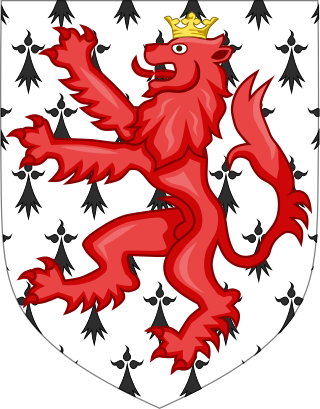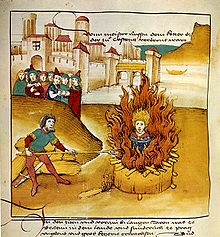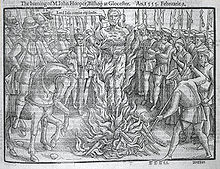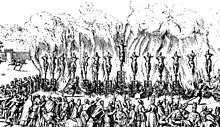
The 16th century began with the Julian year 1501 and ended with either the Julian or the Gregorian year 1600 (MDC), depending on the reckoning used.

Reginald Pole was an English cardinal and the last Catholic archbishop of Canterbury, holding the office from 1556 to 1558, during the Counter-Reformation.

John Rogers was an English clergyman, Bible translator and commentator. He guided the development of the Matthew Bible in vernacular English during the reign of Henry VIII and was the first English Protestant executed as a heretic under Mary I, who was determined to restore Roman Catholicism.

Rowland Taylor was an English Protestant martyr during the Marian Persecutions.

The Marian exiles were English Protestants who fled to continental Europe during the 1553–1558 reign of the Catholic monarchs Queen Mary I and King Philip. They settled chiefly in Protestant countries such as the Netherlands, Switzerland and Germany, and also in France, Italy and Poland.
Joan Bocher was an English Anabaptist burned at the stake for heresy during the English Reformation in the reign of Edward VI. She has also been known as Joan Boucher or Butcher, or as Joan Knell or Joan of Kent.
The Ipswich Martyrs were nine people burnt at the stake for their Lollard or Protestant beliefs around 1515-1558. The executions were mainly carried out in the centre of Ipswich, Suffolk on The Cornhill, the square in front of Ipswich Town Hall. At that time the remains of the medieval church of St Mildred were used for the town's Moot Hall. Later, in 1645 Widow Lakeland was executed on the same site on the orders of Matthew Hopkins, the notorious Witchfinder General.
Ralph Baines or "Bayne" was the last Roman Catholic Bishop of Lichfield and Coventry, in England.
Events from the 1550s in England. This decade marks the beginning of the Elizabethan era.
Thomas Sedgwick (Segiswycke) was an English Roman Catholic theologian. An unfriendly hand in 1562 describes him as "learned but not very wise".
Juan de Villagarcía was a Spanish Dominican from Valladolid, known as the witness to one of the statements of confession and recantation by Thomas Cranmer.
Joan Waste or Wast was a blind woman who was burned in Derby for refusing to renounce her Protestant faith.

James Turberville was an English cleric who served as Bishop of Exeter from 1555 to 1559.
William Chedsey (1510?–1574?) was an English Roman Catholic priest and academic, who became archdeacon of Middlesex in 1556 and President of Corpus Christi College, Oxford in 1558.
The Canterbury Martyrs were 16th-century English Protestant martyrs. They were executed for heresy in Canterbury, Kent and were the last Protestants burnt during the reign of Mary I. Their story is recorded in Foxe's Book of Martyrs.

The Guernsey Martyrs were three women who were burned at the stake for their Protestant beliefs, in Guernsey, Channel Islands, in 1556 during the Marian persecutions.
John Tewkesbury was a Paternoster Row leather merchant in London and Protestant reformer, convicted of heresy and burned at the stake in West Smithfield, London, on 20 December 1531.
John Rough was a Protestant martyr and leader of the London underground church. He was born in Scotland and died in England.


















